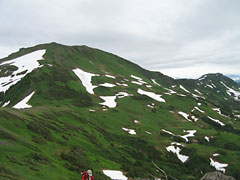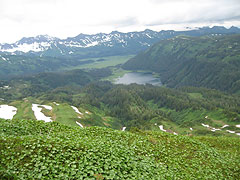

 | |||||||||||
|
|
Journals 2007/2008Louise McMinn
July 12, 2007 Today I hiked along a mountain ridge. Terry Pavlis was mapping the orientation of the rock outcroppings in the areas. Last night we looked at lidar maps that were made last year. Lidar is a mapping technique similar to sonar, only it uses light instead of sound. The light is able to filter through the vegetation, leaving only the bedrock underneath. These maps give a general overview of the geological features underneath, but it is not a perfect science. By examining the area by sight, and taking more measurements, a more accurate map can be developed. The helicopter left us on top of a mountain ridge notated as Tok. The altitude was about 2,400 feet. Here I met my first challenge, climbing down the ridge. The bear flower growing along the side was very slippery, so I slid down most of it. The snow bank along the side was also icy; it was fun to slide down the side of the mountain in the summer!
Terry measured the outcroppings as we walked along. He noted their location using GPS, and measured the angle of orientation. Most of the bedrock was covered with vegetation and soil so it is very difficult to determine what lies underneath.
The scenery was quite breathtaking, mountains and glaciers on one side, and the Martin and Copper River delta on the other. I was surprised at the minimal amount of wildlife I saw; there were very few birds or visible animals around. We did come across bear tracks and scat. At night everyone returned to the cabin and compared their findings. It was very enlightening to me how much teamwork and discussion took place. Every geologist had their own area of expertise, and all were very interested in their colleagues' opinions. Their work is clearly collaborative. |
||||||||||

